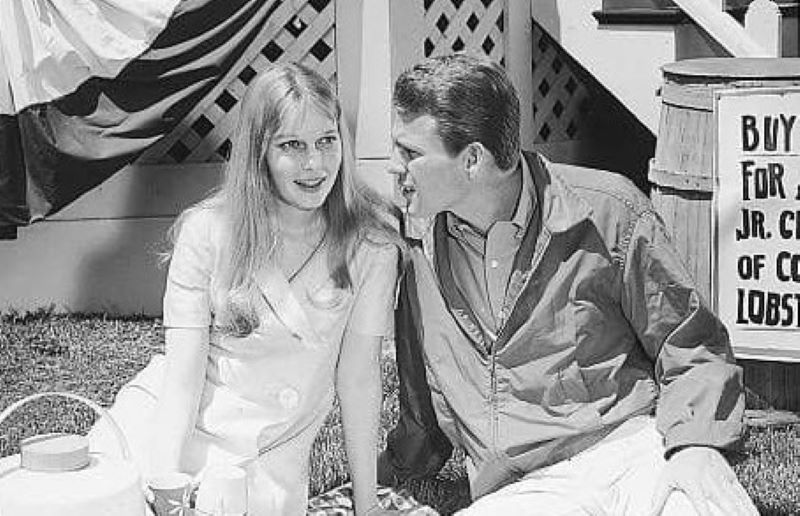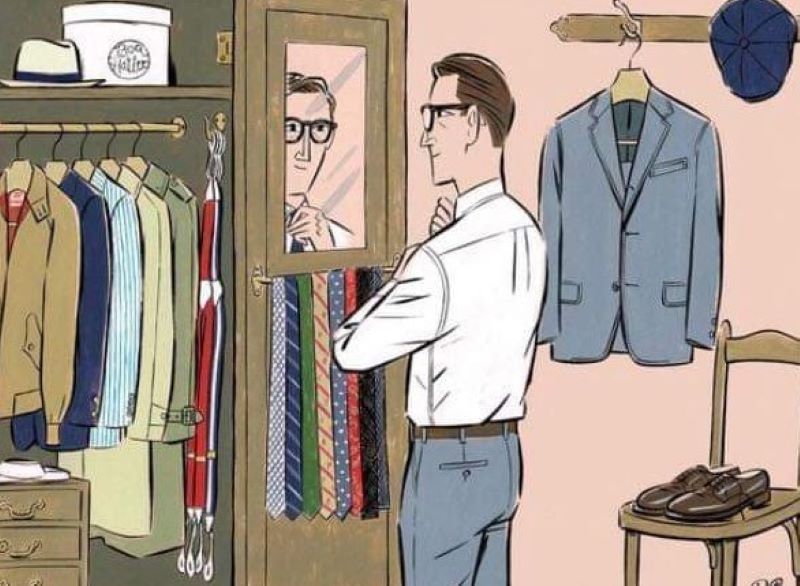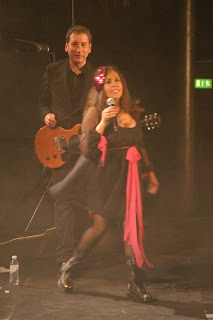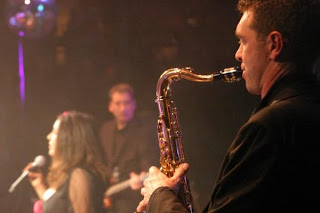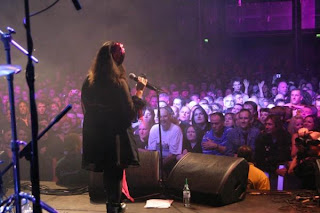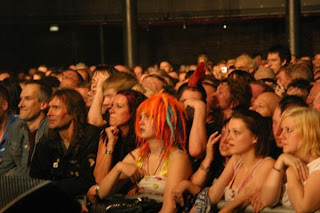Dissension in the Ska Camp
From April 26, 1964–”Something had to come after the Twist and it appears to be the ‘Jamaica Ska,’ just imported from the Caribbean island by dance lovers of New York’s jet set. Here, at Shepheard’s night spot, where the infectious new dance made its U.S. debut, lovely Carol Joan Crawford (left), Miss World of 1964, pays close attention to the dancers. The ‘Ska’ may be simply described as ‘up-beat blues with a shuffle rhythm.’ Its name evolved out of the sound of the guitar’s up-beat stroke. Miss Crawford, who also hails from Jamaica, is currently touring the U.S. for the first time.”
The premiere of the ska in America was controversial then, as it is now. I recently found an article from 1964 called “Dissension in the Ska Camp” that shows even when musicians were in the thick of it, it was a contested issue of who was included and who was excluded, who created it first and who was following suit. So I today I share this article that appeared in the Sunday Gleaner, April 26, 1964 that shows these topics were just as relevant and talked about then as they are now, even more so. The article has no byline so it is not evident who wrote the piece, but Ronnie Nasralla and Prince Buster chime in with their opinions.
First, let’s set the scene. Referenced in this article is the event at Shepheard’s Club, seen above in the photo. This nightclub was located in the Drake Hotel on Park Avenue in Manhattan. It was a hotspot. It was hip and posh and cool. Big stars stayed at the Drake, including Frank Sinatra and Muhammad Ali and later Led Zeppelin and Slade. But Shepheard’s was also swanky and the hot dances of the day, like the Frug, were not only danced here, but unveiled here. So too was the Ska. Shepheard’s even produced a flyer called, “How to Do the Newest Discotheque Dances at Shepheard’s in New York’s Drake Hotel” with step-by-step instructions to dance the Jerk, Watusi, Frug and the Monkey.
The event at Shepheard’s Club was prior to the World’s Fair. This event was held in April, whereas the World’s Fair wasn’t until August of 1964. However, Jamaica’s tourism efforts began before the World’s Fair in anticipation of creating a buzz and capitalizing on the dance craze trend. You may remember the photo I posted with Arthur Murray’s wife and Ronnie Nasralla from this evening at the Shepheard’s Club, and above is another rare gem.
Without further ado, the article:
National sound hits New York but now the argument flares as to what it is and who started it!
DISSENSION IN THE SKA CAMP
LIKE a raging fire, the promotional tour of the Jamaican National Sound, the Ska, has started a smoldering in the underbrush of the Kingston music world from which this distinctive brand of music was born.
Everyone wants to prove who is the true exponent of the Ska and who originated it? What is the authentic style of the Ska dancing? Successful though the promotional tour to the U.S. was, enthusiastic though the reports which came back treat the appearance of a Jamaican troupe of dancers and artistes at the Shepheard’s Club, there is dissension in the camp.
Some artistes who made the trip say their sound was not promoted as much as certain other sounds. Some of the artistes say that some of the other artistes didn’t have a clue about Ska dancing and in fact did the Monkey, the Wobble, the Twist . . . anything but true Ska.
Reports from the other side say that the moves done at Shepheard’s were moves decided on and rehearsed for several nights, together, before the team left the island.
To the accusation that other records were promoted over others, we discover from Mr. Winston Stona of the Jamaican Tourist Board, a co-sponsor of the promotional venture that:
The junket to the Shepheard’s Ska dancing, backed up over recorded music. Shepheard’s is one of a current crop of New York Clubs called discotheques. In this night spot feature entertainment comes from records played on a large turntable, from an amplification booth much like the Jamaican sound system of the dance halls.
According to the Tourist Board spokesman, the promotional venture for the Ska, as suggested by Henri Paul Marshall and Roland Rennie, the music promotion experts who came to the island last month on the invitation of the Ministry of Development and Welfare, was that Ska records and not personal performances by the artistes, would be projected.
The records which were taken to Shepheard’s therefore, were a selection made on the suggestion of the experts who, on their visit to the island, listened to the work of various Ska exponents. The records chosen for promotion were the ones which the experts deemed most likely to catch on with the American public.
These records included the works of Prince Buster, Derryck Morgan, Eric Morris, and others known to the local Ska followers.
Why should there be dissension? Among the tunes featured at Shepheard’s was “Sammy Dead,” the old Jamaican folk tune restyled as Ska by Byron Lee and the Dragonaires, featuring the voice of Eric Morris. Certain members of the troupe to Shepheard’s say “Sammy Dead” was promoted over other tunes.
According to Mr. Stona, “Sammy Dead” was actually played twice at the beginning and at the end of the programme of Ska records which he presented to the Shepheard’s audience.
It was also revealed that “Sammy Dead” which is to be released on a Capitol label in the States was specifically promoted on the request of Capitol records.
Prince Buster and the other early devotees of the Ska say this should not be so. And they throw in the argument that in their opinion “Sammy Dead” is not a true Ska tune and why should it be played even one more time than any of the others, which are reorganized as real Ska by the real Ska fans?
Prince Buster, who took the Ska to England where it is known now as the Blue Beat, was very expressive about this. He says he is one of the originators of the Ska and sees no reason why he and others, who worked together on the National Sound, should not have got as big billing.
But who really originated the Ska? As Buster tells it, it was back in 1958 that he, Derryck Morgan, Eric Morris and others used to meet on top of an old house situated on Charles Street near Orange Street. The meetings were inspired because “as boys together, we were looking at making a brand.”
He points out that a number of Jamaican musicians had tried adopting American shuffle sounds to their own style, but it didn’t really work. There was need for “our own sound.” So those meetings on top of the house was to find out just how to make things work, how to find a Jamaican sound which the fans would go for.
Down on the ground you might say the big sound system operators Duke Reid and Coxson were evolving their own sound. It was an adaptation of certain American shuffle tunes re-recorded for the sound system dance audiences. It is said that when the experimenters offered Duke Reid and Coxson the new Jamaican sound they would have nothing to do with it.
According to Buster, the new sound when it was evolved was referred to with great disdain by other musicians and by the public as the Boop-Boop. He even earned the name Boop. And when he and Derryck Morgan, for a promotional stunt, launched Boop-Boop songs deriding each other the public really went for their skins.
But out West, the thump of the Boop, later is to be called Sca, then Ska, was catching on. Musicians who had “boxed around” in various musical combos began to be reorganized as “Ska beaters.” Out west and on the east, they could tell you and still tell you about Drumbago who played the drums and Ja Jerry, Theophilus Beckford, and Raymond Harper, Rupert “Blues” Miller, and Stanley Notice.
These according to the fans and on Orange Street and (unreadable) where sound boxes thump through the Saturday night of every week were the original ska men.
As the craze progressed, getting popularity most of all on JBC’s Teenage Dance Party, other musicians joined the parade, cut dies, met for sessions, helped the sound to grow.
The fans began to acclaim Baba Brooks, Roland Alphonso, Lloyd Brevet, Lloyd Tate, Don Drummond, Lester Sterling, Johnny Moore, Lloyd Knibb and the men whose full names nobody remembers but rather a name like Jackie, Charlie, and Campbell. Later they were joined by the acclaimed pure jazz, tenor man, Tommy McCook.
The Ska caught on, spread and grew, most of all in the Saturday night sound system headquarters such as Forrester’s Hall, Jubilee Tile Gardens, Carnival and Gold Coast on Sundays.
Sound system operators worked feverishly to get the latest biscuits on disc. Early on release, they bore no labels, but the dance hall spies got the names eventually and the sound system which didn’t have the new biscuit last week, acquired it this week, to draw the fans.
It is interesting to find a parallel in the discotheques which began in Paris and spread to London and New York.
In the process of finding who should get credit for what, it is eye opening to hear Prince Buster saying that Louise Bennett played her part in the promotion of this peculiarly Jamaican sound and dance. He says that Louise’s life work of keeping alive the folk songs and rhythms of Jamaica is responsible for many of them coming back into popularity, set against the Ska beat.
Many of the musicians and artistes associated with the Ska movement are fairly young men. However, one of the acknowledged originators and Dean of the Sound has been playing music in Kingston for 46 years.
He is Drumbago the drummer who also plays a flute. His real name is Arkland Parks and (unreadable) Mapletoft Poulle and Frankie Bonnitto.
Drumbago, a mild mannered gentleman, says he and Rupert Miller, a bass player for 36 years, were in on the original search to find the sound which came to be called Ska. He explains their best arrangement of the sound as being basically four beats to the bar in eight or twelve measures.
“You get the sound according to how you invert the beats,” says Drumbago.
Another exponent of Ska and its various offshoots feel that the dance called Wash Wash has every claim to being truly Jamaican, for it is inspired by one of the basic Jamaican show dances … the wash day scene. This is a standard with many nightclub rhumba dancers, with many folk lore troupes.
So what constitutes Ska dancing? According to the fanatics, true Ska motions are the wash wash, the peculiar washing motion of either clothes or the body, the press along, in which the dancer thumps out the rhythm with his arms at shoulder level, the move (for which we found no
name) of spiraling down to floor level and back up, the one in which you moved the hips and pumped the arms in the opposite direction to the press along.
The fans say that while the extempore movements are allowed dancing the Ska, these are the definite basic movements which one must know to be IN.
Dissenters from the troupe which performed at Shepheard’s say these movements were not used fully or enough and that at one stage they heard a critic saying that what was being done was nothing new, it looked like a first cousin to the Twist. And that the Monkey and the Pony movements which were done were recognized as old hat immediately.
Mr. Stona says this accusation is not true. He found nothing but satisfaction for the presentation at Shepheard’s and is optimistic for the future of Ska promotion in the United States.
We contacted a spokesman for the Byron Lee and the Dragonaires outfit who made “Sammy Dead.”
He told of having heard the feeling expressed by some of the original Ska sound makers that certain orchestras now playing the sound were only cashing in and didn’t know how the sound began.
The Byron Lee spokesman—Mr. Ronnie Nasralla—says:
“For Byron Lee and the Dragonaires it’s not just cashing in. I know Byron feels that it is full time Ska was organized and promoted so that the best can be got out of it for the benefit of the artistes and Jamaica.”
According to Mr. Nasralla:
“Many Ska artistes were not properly protected or organized before Byron Lee has signed up several artistes for recordings and appearances and we’re taking all steps to see that they’re properly presented.”
“I’ve heard that some people say that Byron Lee is just promoting his orchestra. It’s not true. Sure, as a businessman he will look out for his investments, but let us stop quarrelling among ourselves and promote the sound not only for the good of one band but for all Jamaica.”
Whatever comes of it, Ska is going to be a talking point for many more months. Ironically, like most things, it was an art without honour in its own country until it was discovered somewhere else.
Stay tuned for next week’s blog when I will post a response to this article that appeared in the Daily Gleaner the following Sunday. Apparently the comments made by Ronnie Nasralla and Prince Buster struck a chord and a number of musicians responded with their thoughts, including Eric Monty Morris, Roy Panton, Ronnie Nasralla again, Alphanso Castro, Sir Lord Comic, and Roy Willis who respond with comments of their own.





















